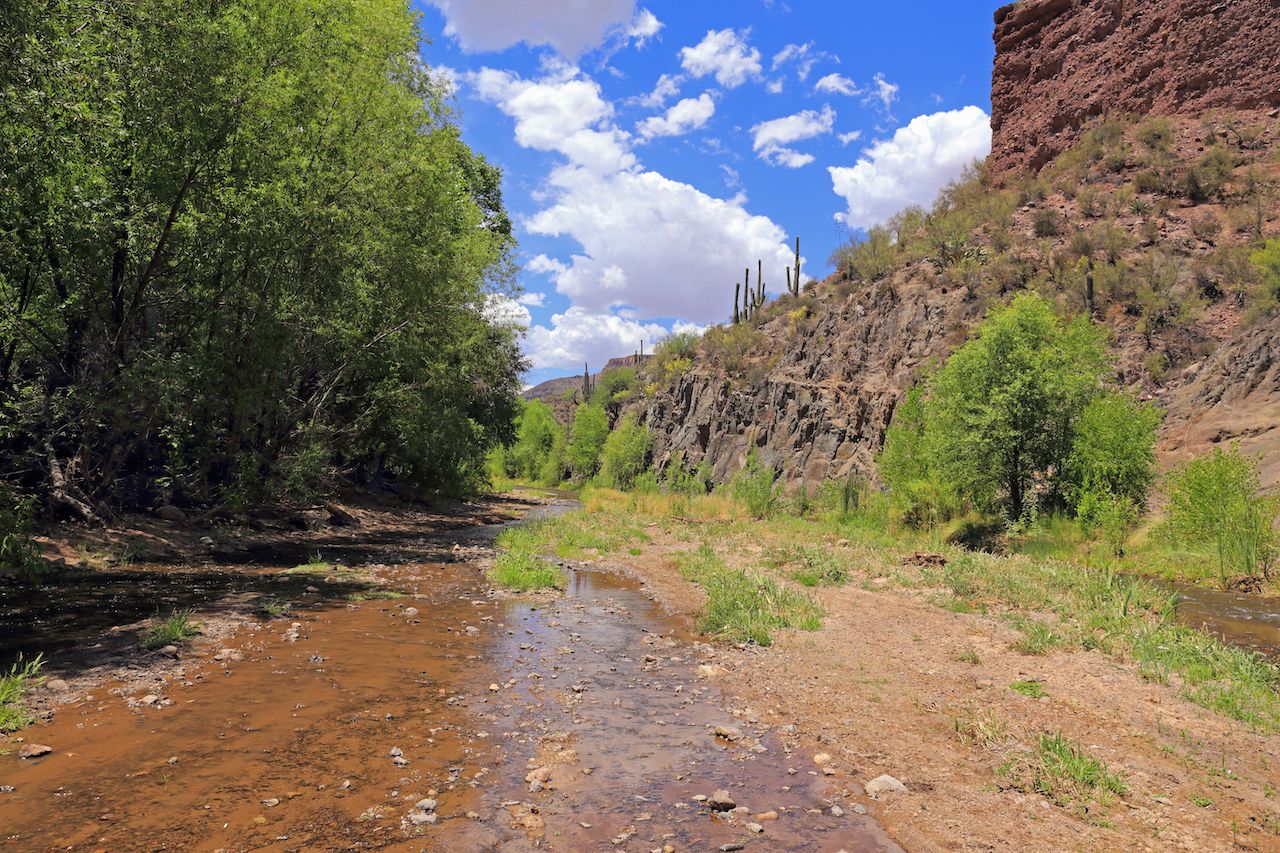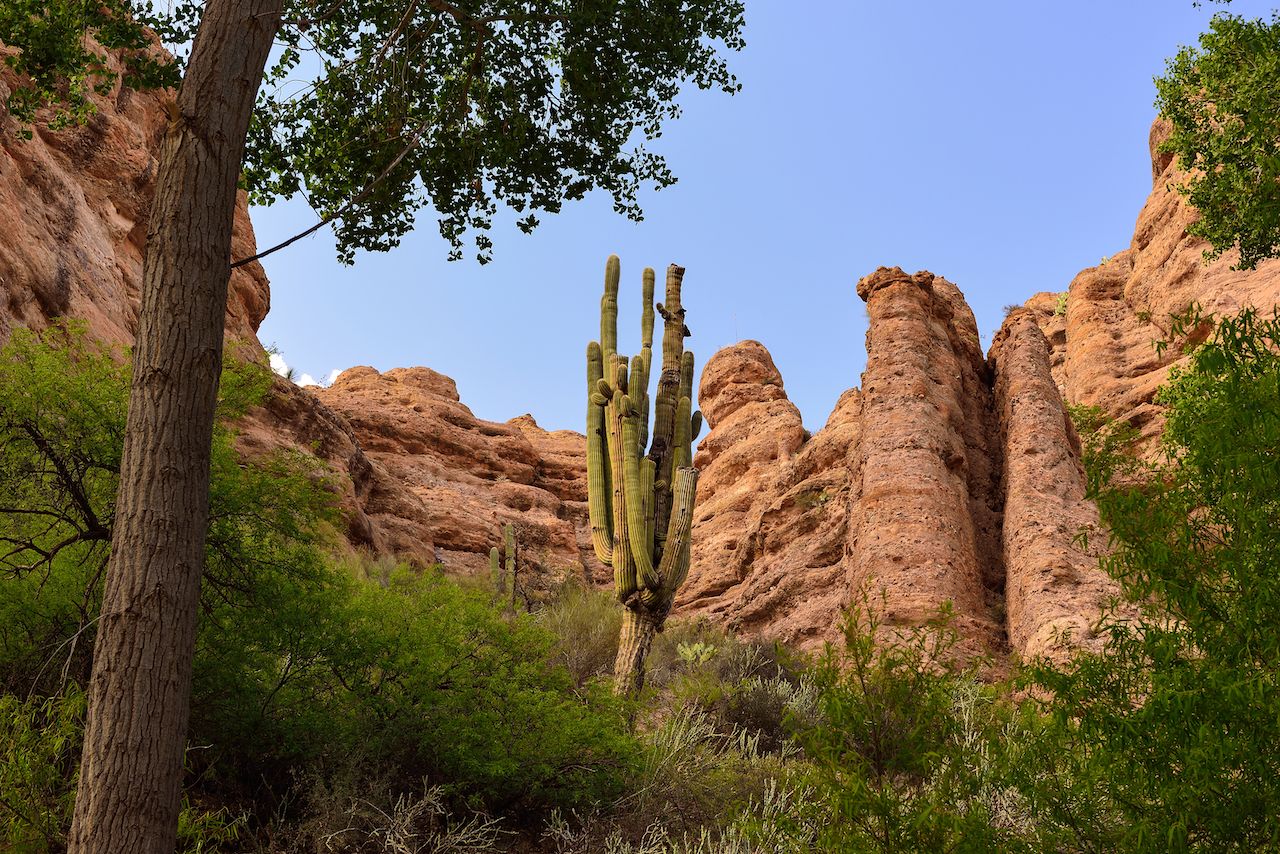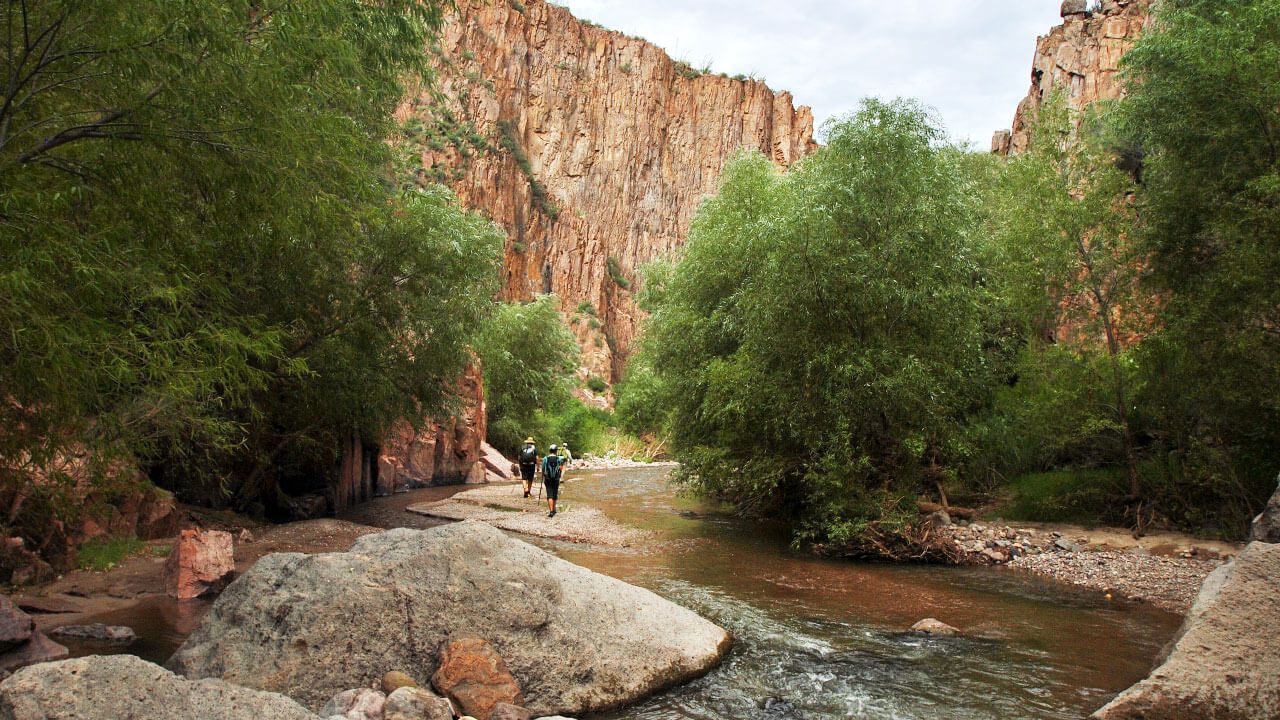Arizona is home to some of the most diverse and well-known natural landscapes in the United States, including the red rocks of Sedona, Grand Canyon National Park, and the isolated mesas of Monument Valley. But for the first-time backpacker looking for a truly unique wilderness canyon experience, Aravaipa Canyon is the most ideal destination in the state. Here, saguaro cacti watch vigilantly over the desert landscape as you trek along the waterfront down below, away from both the heat of the desert and the crowds of the national parks to the north. Towering sandstone cliffs provide a colorful backdrop as the sun rises and sets on the canyon walls. Here’s how to put a backpacking trip together to Aravaipa Canyon.

Arizona's Aravaipa Canyon Is Perfect for First-Time Backpackers. Here's Why.
What makes Aravaipa Canyon ideal for newbie backpackers

Photo: Bill Florence/Shutterstock
The biggest perk of Aravaipa Canyon is its ease of access from both Phoenix and Tucson. Instead of driving north to the packed trails of the Grand Canyon, Aravaipa is located just 120 miles southeast of Phoenix, and on the way down you’ll pass the jagged peaks of the Superstition Mountains before turning south on the largely traffic-free Highway 70. The roughly 20,000-acre Aravaipa Canyon Wilderness is a veritable oasis in a landscape otherwise dominated by hot, open desert, and the canyon itself is relatively small with easy trailhead access.
The canyon is the best place in southern Arizona for wildlife spotting. Aravaipa Creek meanders through the rock, lined with cottonwoods, willows, and other lush vegetation thanks to the perpetual flow of water in this riparian ecosystem. Over 300 species of animals call this desert environment home, with more than 200 of them being birds. You might also spot bighorn sheep, coatis, and javelinas wandering the area, and there is also the elusive mountain lion — though your odds of seeing one are low.
How to plan and execute your backpacking trip

Photo: mdstory/Shutterstock
The first thing to know about any outdoor excursion is what the weather is going to be like. The average daily temperature in Aravaipa Canyon is about 10 degrees cooler than that of Phoenix in the peak of summer, but it’s still upward of 95 degrees on most days and not exactly ideal for carrying a heavy pack and gear. But the ideal time to visit has more to do with water conditions than with temperature. March-May and October-November are peak season. In the summertime, temperatures can be exceedingly high and flash floods are more likely to occur without warning.
While the area is still relatively unknown to the backpacker circuit, you do need a permit. Permits are available online 91 days before your start date, and are issued for the number of days you want to be in the backcountry, not the number of nights. That means you’ll need to have a permit even for day use. You’ll need to select whether you want to enter from the east entrance or west entrance, and the maximum number of days is three. Only 50 people are allowed to enter per day.
If that sounds intimidating, don’t worry. It’s not a popular backpacking area, and permits are usually available no more than a week or two ahead of time, especially if you’re looking to visit midweek. Make sure you have a Recreation.gov account to pay for your permit (which costs $5 per person, per day, plus a $6 processing fee).

Photo: RCole3/Shutterstock
The canyon is accessible from one of two trailheads. The west entrance is easier to access for general trekkers and backpackers, while the more remote east entrance requires a 4×4 to navigate the challenging roads to the trailhead. If you’re planning to hike the entire length of the roughly 11-mile canyon, it will require shuttling a car between trailheads. This can be avoided by using an outfitter that handles this logistic. If you plan to day hike in the canyon, the west entrance may be the best option because of its easier road access.
While the entire hike can be done in one day by seasoned hikers, spending multiple days within the canyon is required to fully embrace the experience. You’re on a backpacking trip, after all. Optional side hikes within the canyon allow hikers to explore the cascading waterfalls of Horse Camp Canyon and Hellhole Canyon (more commonly referred to as Deer Creek Canyon), which is anything but what its name might imply. Both are easily accessed via well-marked trails within Aravaipa. Allow one or two nights to camp and rest up at the first-come, first-served designated campsites. While securing a place to set up your tent won’t be a problem with your permit, hitting the trail before midday is the best way to get a prime one.
What to wear
Leave the boots at home. Depending on the season, you’ll likely spend 60 to 90 percent of your time in the water, which can include river crossings or just walking right down the middle of the shallow waterway while canyon walls rise on either side of you. With that said, sandals or water shoes like the Eleu Trainer are the best options. These options provide additional protection with most having a hard rubber covering over the toes that can prove advantageous when navigating the rocky river bottom. They still dry quickly and water drains freely once out of the creek. Consider bringing a spare pair of shoes to wear around camp. If you’re comfortable with the sandal option, strap them on and go — don’t bring your flip-flops.
Also, remember that you’re in the desert — daytime temperatures during the summer can often jump into the triple digits but can also plummet at night, so pack accordingly. Consider bringing a warm jacket and a change of clothes on the off-chance you take an unexpected swim during the day.
Opt for the guided tour

Photo: REI
First-time backpackers looking for a bit of professional guidance and tips can do so by trekking with an outfitter. Don’t worry about sacrificing any dignity by doing so — there’s ample value in securing the expertise and guidance of a professional guide and you’ll learn a ton about both backpacking best practices as well as the landscape you’re passing through. A limited number of people are allowed into the canyon daily and utilizing a guide service like REI Adventures can make that process easier. Despite being a four-day adventure, this option is perfect for the beginner as well as experienced backpackers. In addition to providing ground transportation to and from the trailhead — thus negating the need to shuttle a vehicle between the end and starting point — outfitters will provide all necessary group gear, an informative geological and historical tour through the canyon, and most importantly, gourmet backcountry meals prepared creekside.